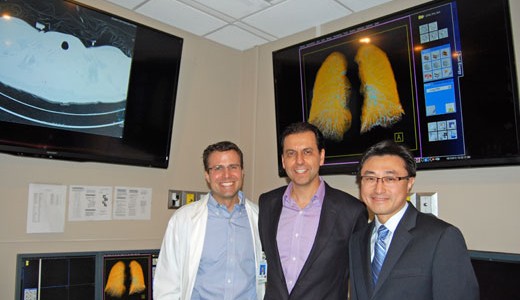VGH ED radiologists make history
Dr. Luck Louis is burning the midnight oil.
Starting October 1, the emergency trauma radiologist and nine of his VGH and UBCH colleagues began a 24/7 rotation at the VGH Emergency Department (ED). Previously, radiologists were on call between 11 pm and 8 am, a common practice in Canada.
“Smaller hospitals don’t have the manpower or resources to offer 24/7 service while larger hospitals simply offer on-call radiology services from home,” says Dr. John Mayo, medical director, medical imaging, Vancouver Acute. “But we asked ourselves: is this really the best service for patients?”
The change in service model will enhance patient care and mark VGH as a Canadian leader in radiology – again.
Integral members of trauma team
VGH was the first hospital in Canada to develop the sub-specialty of Emergency Trauma Radiology. As the first Emergency Radiology Fellow trained at VGH, Dr. Luck Louis — or Luck — takes pride in the difference this sub-specialty makes on patient outcomes. Quite simply: it helps saves lives.
“There was no such thing as Emergency Radiology when I began my career,” he says, “but today, radiologists are an integral part of the trauma team, providing essential, life-and-death information in real time, as the patient is scanned.”
Now, with the expansion to 24/7 on-site service, Luck says patient care will only get better. “Our Residents and Fellows have always done a fine job, but the complexity of radiology has increased substantially over the years, and ED volumes continue to rise,” he explains.
“As emergency radiologists, we strongly believe in the strength of the team, and we’re making this commitment to work on-site 24/7 because it’s the right thing to do for patients and for referring physicians.”
Dr. Doug McKnight, for one, is pleased. “This is a great advance,” says head of the VGH ED and UBCH Urgent Care Centre. “Personally, I’m excited because this expansion of service will enhance care for patients in the ED and the rest of VGH, too.”
Preventing unnecessary transfers
Luck and his colleagues will also begin sharing their specialized knowledge of trauma imaging with emergency physicians and trauma surgeons across B.C. Using 70-inch high-definition monitors and a secure corporate iPhone platform, VGH emergency radiologists will be able to view images at other B.C. hospitals and consult with physicians via video.
“This has the potential for radiologists to uncover critical findings that could have been overlooked by local physicians,” says Dr. Savvas Nicolaou, head of the Division of Emergency Trauma Radiology. “We can also potentially avoid a transfer to VGH because the radiologist determines the patient can recover in a hospital closer to home.”
And that means more VGH beds for patients with more urgent needs.
Luck sees another potential, too: less duplication of work. “When patients are transferred, we’re often asked to reinterpret images,” he explains. “Our new technology will help eliminate unnecessary work so we can help speed patient care and try and stay ahead of the curve.”
The curve Luck is referring to is the growing demand for ED services. Since 2009/10, ED admissions have increased almost 14 per cent or by about 2,300 visits per year. Based on population growth, and assuming no other changes to the current use rate or referral patterns, the rate of demand is expected to increase even more.
Still, taking on a 24/7 rotation is a change of lifestyle for radiologists and their families. Ask Luck how he feels about this and he says:
“When I do sleep, I sleep better knowing that patients are taken care of.”

